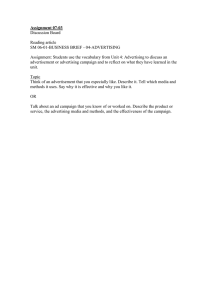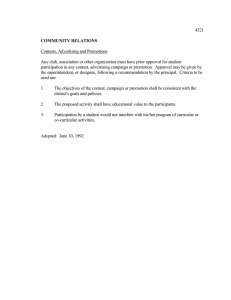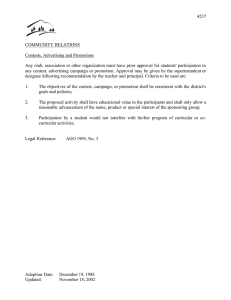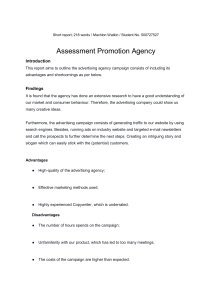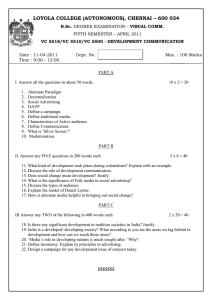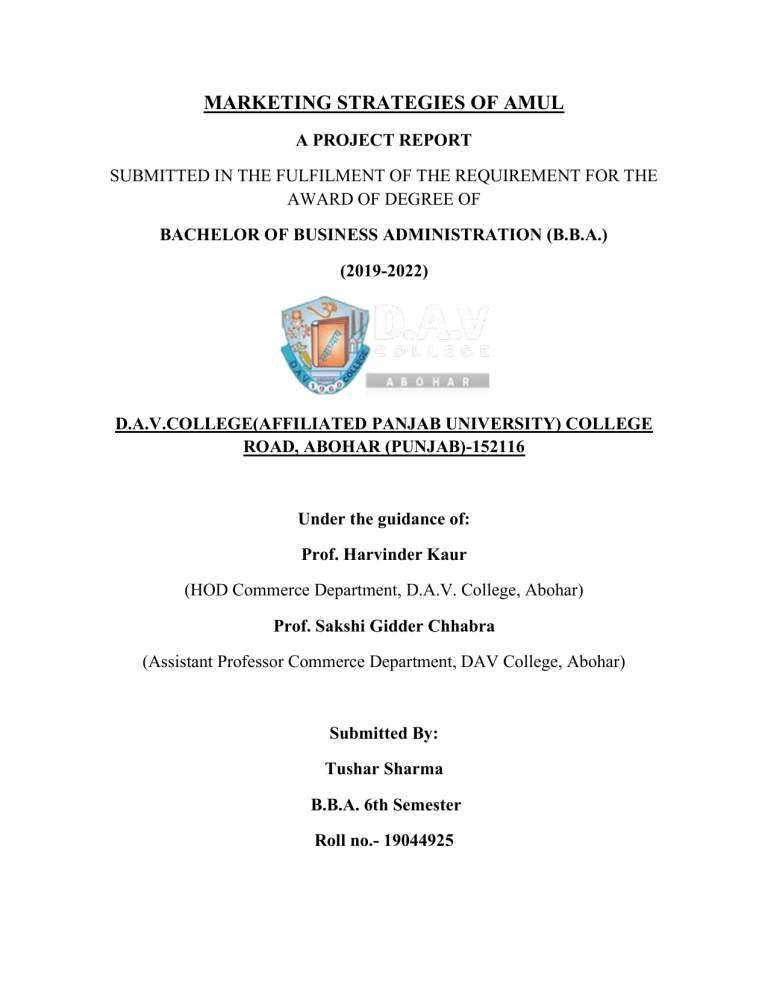
MARKETING STRATEGIES OF AMUL A PROJECT REPORT SUBMITTED IN THE FULFILMENT OF THE REQUIREMENT FOR THE AWARD OF DEGREE OF BACHELOR OF BUSINESS ADMINISTRATION (B.B.A.) (2019-2022) D.A.V.COLLEGE(AFFILIATED PANJAB UNIVERSITY) COLLEGE ROAD, ABOHAR (PUNJAB)-152116 Under the guidance of: Prof. Harvinder Kaur (HOD Commerce Department, D.A.V. College, Abohar) Prof. Sakshi Gidder Chhabra (Assistant Professor Commerce Department, DAV College, Abohar) Submitted By: Tushar Sharma B.B.A. 6th Semester Roll no.- 19044925 Preface Bachelor of Business Administration program is one of the most reputed courses in the field of management. This course includes both theory and some practical knowledge. This project report is the part of the pedagogy of BBA program in D.A.V. College, Abohar under Panjab University. It gives exposure to our practical knowledge and also interacts with various aspects of present market strategies. Each student is require to start working on project report as soon as semester ends and complete the report till the end of sixth semester. The Project is designed to present a real life study on the real life situation are different from theoretical aspect. The project presented here is a result of my hard work. This project helps me to learn about Marketing Strategies of AMUL. Tushar Sharma BBA 6th Semester Certificate This is to certify that Tushar Sharma a student of B.B.A. 6th Semester of D.A.V. College, Abohar has undertaken the Project under my guidance for the project titled “Marketing Strategy of AMUL.” This project report is prepared in partial fulfilment for the award of the degree of Bachelor of Business Administration. The work included in the project is all original and done by him. Date: Place: Sakshi Gidder Chhabra (Assistant Professor Commerce Department D.A.V College, Abohar) Acknowledgement The satisfaction of successful completion of any task would not be complete without the expression of gratitude to the people who made it possible. I am very thankful to Mrs Sakshi Giddar Chhabra (Assistant Professor of Commerce Department of D.A.V College, Abohar) for the guidance and interest evinced throughout the preparation of the project. I also extent my gratitude to the respondents of my survey for their kind cooperation. TUSHAR SHARMA B.B.A 6th Semester INDEX ❖ Chapter 1: Introduction…………………………………………………8-22 • Market …………………………………………………………9-10 • Marketing ………..…………………………………………….12-14 • Marketing Strategies ………………………………………….. • Role Of Marketing Strategies • Advantages and Disadvantages of Marketing Strategies • Types of Marketing Strategies • Chapter: 1 Introduction To Marketing Strategy Market What Is a Market? A market is a place where parties can gather to facilitate the exchange of goods and services. The parties involved are usually buyers and sellers. The market may be physical like a retail outlet, where people meet face-to-face, or virtual like an online market, where there is no direct physical contact between buyers and sellers. KEY TAKEAWAYS • • • • A market is a place where buyers and sellers can meet to facilitate the exchange or transaction of goods and services. Markets can be physical like a retail outlet, or virtual like an e-retailer. Other examples include the illegal markets, auction markets, and financial markets. Markets establish the prices of goods and services that are determined by supply and demand Types of Markets 1. Physical Markets - Physical market is a set up where buyers can physically meet the sellers and purchase the desired merchandise from them in exchange of money. Shopping malls, department stores, retail stores are examples of physical markets. 2. Non Physical Markets/Virtual markets - In such markets, buyers purchase goods and services through internet. In such a market the buyers and sellers do not meet or interact physically, instead the transaction is done through internet. Examples - Rediff shopping, eBay etc. 3. Auction Market - In an auction market the seller sells his goods to one who is the highest bidder. 4. Market for Intermediate Goods - Such markets sell raw materials (goods) required for the final production of other goods. 5. Black Market - A black market is a setup where illegal goods like drugs and weapons are sold. 6. Knowledge Market - Knowledge market is a set up which deals in the exchange of information and knowledge based products. 7. Financial Market - Market dealing with the exchange of liquid assets (money) is called a financial market. Marketing What Is Marketing? Marketing refers to activities a company undertakes to promote the buying or selling of a product or service. Marketing includes advertising, selling, and delivering products to consumers or other businesses. Some marketing is done by affiliates on behalf of a company. Professionals who work in a corporation's marketing and promotion departments seek to get the attention of key potential audiences through advertising. Promotions are targeted to certain audiences and may involve celebrity endorsements, catchy phrases or slogans, memorable packaging or graphic designs and overall media exposure. KEY TAKEAWAYS • • • Marketing refers to all activities a company does to promote and sell products or services to consumers. Marketing makes use of the "marketing mix," also known as the four Ps—product, price, place, and promotion. At its core, marketing seeks to take a product or service, identify its ideal customers, and draw the customers' attention to the product or service available. Understanding Product, price, place, and promotion are the Four Ps of marketing. The Four Ps collectively make up the essential mix a company needs to market a product or service. Neil Borden popularized the idea of the marketing mix and the concept of the Four Ps in the 1950s. Product refers to an item or items the business plans to offer to customers. The product should seek to fulfill an absence in the market, or fulfill consumer demand for a greater amount of a product already available. Before they can prepare an appropriate campaign, marketers need to understand what product is being sold, how it stands out from its competitors, whether the product can also be paired with a secondary product or product line, and whether there are substitute products in the market. Price Price refers to how much the company will sell the product for. When establishing a price, companies must consider the unit cost price, marketing costs, and distribution expenses. Companies must also consider the price of competing products in the marketplace and whether their proposed price point is sufficient to represent a reasonable alternative for consumers. Place Place refers to the distribution of the product. Key considerations include whether the company will sell the product through a physical storefront, online, or through both distribution channels. When it's sold in a storefront, what kind of physical product placement does it get? When it's sold online, what kind of digital product placement does it get? Promotion Promotion, the fourth P, is the integrated marketing communications campaign. Promotion includes a variety of activities such as advertising, selling, sales promotions, public relations, direct marketing, sponsorship, and guerrilla marketing. Promotions vary depending on what stage of the product life cycle the product is in. Marketers understand that consumers associate a product’s price and distribution with its quality, and they take this into account when devising the overall marketing strategy. What Are the Goals of Marketing? An important goal of marketing is propelling a company’s growth. This can be seen through attracting and retaining new customers. Companies may apply a number of different marketing strategies to achieve these goals. For instance, matching products with customers' needs could involve personalization, prediction, and essentially knowing the right problem to solve. Another strategy is creating value through the customer experience. This is demonstrated through efforts to elevate customer satisfaction and remove any difficulties with the product or service. Marketing Strategies What Is a Marketing Strategy? A marketing strategy refers to a business's overall game plan for reaching prospective consumers and turning them into customers of their products or services. A marketing strategy contains the company’s value proposition, key brand messaging, data on target customer demographics, and other high-level elements. A thorough marketing strategy covers "the four Ps" of marketing—product, price, place, and promotion. KEY TAKEAWAYS • • • A marketing strategy is a business's game plan for reaching prospective consumers and turning them into customers of their products or services. Marketing strategies should revolve around a company's value proposition. The ultimate goal of a marketing strategy is to achieve and communicate a sustainable competitive advantage over rival companies. Understanding Marketing Strategies A clear marketing strategy should revolve around the company's value proposition, which communicates to consumers what the company stands for, how it operates, and why it deserves their business. This provides marketing teams with a template that should inform their initiatives across all of the company's products and services. For example, Walmart (WMT) is widely known as a discount retailer with “everyday low prices,” whose business operations and marketing efforts are rooted in that idea.1 ROLE OF MARKETING STRATEGIES The broad purpose of a marketing plan is to advance the exposure of your product or company, depending on the specific goal of that plan. When you develop your marketing strategy, it is important to understand the various roles a marketing plan fills when it is in effect. By understanding the roles of a marketing plan, you are better equipped to create an effective strategy. Product Your marketing strategy identifies the strengths of your product, according to the business experts at the Microsoft website. Part of your marketing plan's purpose is to explain, in detail, the many benefits of your product and how your customers can realize some sort of return by using your product. For the customer, that return could be in the form of saving money, or it could be a competitive advantage that grabs more market share. The marketing strategy also identifies the ways in which your product is superior to the competition, and the reasons why your customers should consider your product over the competition. Audience One important role of a comprehensive marketing strategy is a detailed description of the target audience, according to marketing expert Michael Goodman writing on the Intel website. In order to create effective marketing campaigns, your strategy needs to identify important details about the customer demographic that you have determined to be the best fit for your campaign. Some of those details include age group, median income, geographic location and the advertising medium that would best be used to reach that target buying group. Competition In order to develop an effective marketing campaign, your marketing strategy needs to offer a detailed description of the competition, according to the small business experts at the Center for Business Planning website. The role of the marketing strategy is to give historical information on how the competition has advertised products in the past, the target market the competition goes after and the product features that the competition offers. Other factors such as competition pricing, the competition's distribution network and the sales methods of the competition are also part of a comprehensive marketing strategy. Revenue A marketing strategy is used to determine the revenue that the campaign will deliver. All of the parts that go into determining revenue, including the budget allotted to the campaign, product cost, selling price and the life span of the product, should all be part of the marketing strategy. The revenue goal can be measured against the actual revenue, and that information can be used to create future marketing strategies that are more successful. Advantages & Disadvantages of Marketing Strategies Advantage: Promotes Your Business to a Target Audience You can’t sell your products or services without appealing to the people most likely to buy those products and services. That group is known as your target audience, and a marketing strategy is the most effective way to reach that all-important group. If you have targeted this group correctly, you know their habits, behaviors, wants, and needs, and you also know where they like to hang out on social media. This information shapes the methods you will use to promote your business. For example, if you own a comic book store, online marketing can be more beneficial than traditional advertising to help you reach your audience on social media platforms. Advantage: Helps You Understand Your Customers You have to do market research before you develop a marketing strategy, and that research can provide you with reams of data that you can use over and over to help refine your product development and to keep up with trends and shifts in your target audience’s behavior. With the evolution of digital information, even small businesses have access to hyper-detailed information about prospective customers. This is known in the digital world as “big data,” large data sets that give you a deep analysis into customer behavior based on factors such as online activity, buying activity, mobile activity, and interactions at stores and shops. Disadvantage: Costs of Marketing Although the digital revolution has somewhat evened the playing field, the truth is that small business is still at a disadvantage, when it comes to grabbing their share of eyeballs through their marketing efforts. Big data has great value, but accessing that data is expensive, and you have to keep analyzing that data to stay abreast of buyer trends. Launching a marketing campaign on your website can also be expensive, especially if you’re using a pay-per-click strategy to attract more prospects. Television and radio advertising spots are also costly, and even local advertising space is at a premium, because there is so much competition for the local audience. Disadvantage: Time and Effort May Not Yield a Return Big brands can afford to spend time and effort working on a marketing campaign that fails, because they have the resources to regroup and move on. As a small business owner, however, the return on investment on a marketing campaign may be low, and that means you have spent months crafting a strategy that did nothing to help your bottom line. Even the most wellplanned marketing campaigns fail, and at the small business level, that can set you back for months. Types of Marketing Strategies There are different types of marketing strategies available. Picking up a marketing strategy includes analyzing the needs of your business, your target audience and specifications of your products. The two main types of marketing strategy are: • 1. Business to business (B2B) marketing • 2. Business to consumer (B2C) marketing The most common form of marketing is business to consumer (B2C) marketing. Let’s explore a bit more. Following are the different types of marketing strategies available. 1. Paid advertising This includes multiple approaches for marketing. It includes traditional approaches like TVCs and print media advertising. Also, one of the most well-known marketing approach is internet marketing. It includes various methods like PPC (Pay per click) and paid advertising. 2. Cause marketing Cause marketing links the services and products of a company to a social cause or issue. It is also well known as cause related marketing. 3. Relationship marketing This type of marketing is basically focused on customer building. Enhancing existing relationships with customers and improving customer loyalty. 4. Undercover marketing This type of marketing strategy focuses on marketing the product while customers remain unaware of the marketing strategy. It is also known as stealth marketing. 5. Word of mouth It totally relies on what impression you leave on people. It is traditionally the most important type of marketing strategy. Being heard is important in business world. When you give quality services to customers, it is likely that they’d promote you. 6. Internet marketing It is also known as cloud marketing. It usually happens over the internet. All the marketing items are shared on the internet and promoted on various platforms via multiple approaches. 7. Transactional marketing Sales is particularly the most challenging work. Even for the largest retailers, selling is always tough especially when there are high volume targets. However with the new marketing strategies, selling isn’t as difficult as it was. In transactional marketing the retailers encourage customers to buy with shopping coupons, discounts and huge events. It enhances the chances of sales and motivates the target audience to buy the promoted products. 8. Diversity marketing It caters diverse audience by customizing and integrating different marketing strategies. It covers different aspects like cultural, beliefs, attitudes, views and other specific needs. Introduction to Dairy Industry
